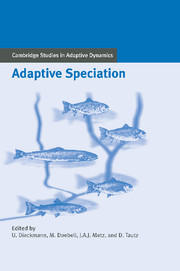Book contents
- Frontmatter
- Contents
- Contributing Authors
- Acknowledgments
- Notational Standards
- 1 Introduction
- 2 Speciation in Historical Perspective
- A Theories of Speciation
- B Ecological Mechanisms of Speciation
- 8 Speciation and Radiation in African Haplochromine Cichlids
- 9 Natural Selection and Ecological Speciation in Sticklebacks
- 10 Adaptive Speciation in Northern Freshwater Fishes
- 11 Sympatric Speciation in Insects
- 12 Adaptive Speciation in Agricultural Pests
- 13 Ecological Speciation in Flowering Plants
- 14 Experiments on Adaptation and Divergence in Bacterial Populations
- C Patterns of Speciation
- References
- Index
14 - Experiments on Adaptation and Divergence in Bacterial Populations
Published online by Cambridge University Press: 05 July 2014
- Frontmatter
- Contents
- Contributing Authors
- Acknowledgments
- Notational Standards
- 1 Introduction
- 2 Speciation in Historical Perspective
- A Theories of Speciation
- B Ecological Mechanisms of Speciation
- 8 Speciation and Radiation in African Haplochromine Cichlids
- 9 Natural Selection and Ecological Speciation in Sticklebacks
- 10 Adaptive Speciation in Northern Freshwater Fishes
- 11 Sympatric Speciation in Insects
- 12 Adaptive Speciation in Agricultural Pests
- 13 Ecological Speciation in Flowering Plants
- 14 Experiments on Adaptation and Divergence in Bacterial Populations
- C Patterns of Speciation
- References
- Index
Summary
Introduction
The basis of biological diversity continues to be the subject of intense study. Numerous causes of biodiversity have been identified, including adaptation, spatial heterogeneity, ecological interactions, genetic drift, and phylogenetic history. However, the general importance of these and other possible causes has proved difficult to quantify. Much of the difficulty arises from the historical nature of evolution. Evolutionary change can take many generations, which severely limits studies that examine the dynamics of diversification. Compounding this problem are limits to true replication in studies of extant diversity and an inability to examine directly the past selective conditions, both of which again result from the historical nature of evolution. While several approaches have been successful in overcoming some of these difficulties (e.g., Schluter 1996a), general conclusions have been hard to obtain.
A complementary approach to examining extant populations (Endler 1986) is to perform experimental evolution under controlled laboratory conditions (Dykhuizen 1990; Lenski 1995). By performing natural selection experiments in the laboratory, both the selective conditions and the initial genetic composition of the evolving populations can be controlled. Thus, difficulties that arise from limited replication and uncertain selective history are circumvented and evolutionary responses can be attributed directly to the known conditions under which the experiment was performed.
Experimental evolution is particularly powerful when coupled with organisms of short generation times, such as bacteria. With appropriately chosen bacterial species, several thousand generations of evolution can be accomplished during a single year.
- Type
- Chapter
- Information
- Adaptive Speciation , pp. 278 - 300Publisher: Cambridge University PressPrint publication year: 2004
- 1
- Cited by



